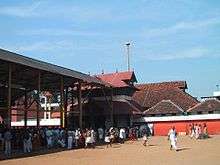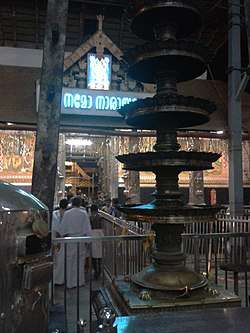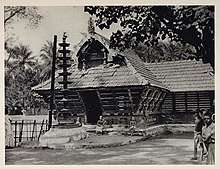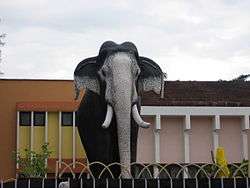Guruvayur Temple
Guruvayur Sri Krishna Temple is a Hindu temple dedicated to the Hindu god Guruvayurappan (a four-armed form of the Hindu god Vishnu), located in the town of Guruvayur in Kerala, India. It is one of the most important places of worship for Hindus in Kerala and is often referred to as Bhuloka Vaikunta (Holy Abode of Vishnu on Earth).[2]
| Guruvayoor Temple | |
|---|---|
 Guruvayur Sri Krishna Temple | |
| Religion | |
| Affiliation | Hinduism |
| District | Thrissur |
| Deity | Vishnu (with four arms at the time of Krishna avatar) - known as Guruvayurappan) |
| Festivals | Janmashtami, Kumbham Utsavam, Ekadasi |
| Governing body | Guruvayur Devaswom |
| Location | |
| Location | Guruvayur |
| State | Kerala |
| Country | India |
 Location in Kerala | |
| Geographic coordinates | 10.5945°N 76.0390°E |
| Architecture | |
| Type | Kerala Architecture |
| Creator | As per tradition, Vishwakarma (sculptor) Brihaspati and Vayu (pratishta) |
| Completed | Believed to be around 5000 years old |
| Inscriptions | Murals |
| Elevation | 12[1] m (39 ft) |
| Website | |
| www | |
The presiding deity of the Guruvayur Temple is Vishnu, worshipped in the form of his avatar Krishna. The central icon is a four-armed standing Vishnu carrying the conch Panchajanya, the discus Sudarshana Chakra, the mace Kaumodaki, and a lotus with a Holy basil garland. This image represents the majestic form of Vishnu as revealed to Krishna's parents Vasudeva and Devaki around the time of Krishna's birth. Worship proceeds according to routines laid down by Adi Shankara and later written formally in the Tantric way, the inter-religious spiritual movement that arose in medieval India, by Chennas Narayanan Nambudiri (born in 1427). The Chennas Nambudiris are the hereditary tantris (high priest) of the Guruvayur Temple.[3]
The temple is managed by a special Devaswom (Guruvayur Devaswom) under the control of the Government of Kerala. The main festivals of this temple are the 10-day festival in the Malayalam month of Kumbham starting with flag hoisting on Pooyam star,[4] Sri Krishna Janmashtami (Birthday of Lord Krishna) in the month of Chingam,[5] Ekadasi (11th day) in the shukla paksha (bright fortnight) in the month of Vrischikam, popularly called as Guruvayur Ekadasi[6] and Vishu on the first day of the month of Medam, once a harvest festival.[5] The temple's sub-deities are Ganapathi, Ayyappan and Bhagavathi, and there are two sub-temples each, one for Ganapathi and the other for Nagadevata nearby the temple.
History
Guruvayur Mahatmyam – early legend of Guruvayur temple

According to legend, Janamejaya conducted a sacrifice to destroy all the snakes of the world including Takshaka, who was the cause of his father Parikshit's death. Hundreds of thousands of snakes fell into the sacrificial fire and were killed, but the sacrifice was stopped by a Brahmin called Astika, before Takshaka was killed.[7]
Since Janamejaya was responsible for the death of millions of snakes, he was afflicted with leprosy. He lost all hope of a cure. One day Sage Atreya (son of Atri) came before Janamejaya and told him to take refuge under the feet of Krishna at Guruvayoor. Atreya told him that in the temple at Guruvayur the effulgence of Sri Hari is at its best and Vishnu showers his blessings on all devotees. He immediately rushed there and spent the next ten months worshipping the god of Guruvayur. At the end of ten months, he returned home healthy and took the astrologer to task for making a false prediction. The astrologer told him that he would find the mark of a snakebite on his left leg. He had escaped death only because he was at that time in a temple where Anantha (the emperor of serpents) was present and Anantha was the brother to the God at Guruvayur where he had finished worshipping.[7]
The king then decided to build a full-fledged temple at Guruvayur. In time, this temple came to be downgraded and reduced to poverty during the days when Kerala was ruled by the Perumals. The Perumal rulers were mostly Shaivites and did not extend their patronage to Vaishnavite shrines. The Shiva temple at Mammiyur received their patronage and with the shift of royal patronage, the worshippers also moved to the Shiva temple. The Guruvayur temple was thus reduced to utmost poverty. However, one day, a holy man went to the Mammiyur temple for food and hospitality for the night. Though the temple was affluent, the temple authorities pretended they had nothing and scornfully directed him to the neighbouring Guruvayur temple. When the holy man entered the precincts of that temple, he was courteously received by a Brahmin boy and sumptuously fed. The holy man was very much pleased and he pronounced a blessing. According to the legend, Mammiyur Siva temple began to decline, and the fortunes of Guruvayur Vishnu temple progressed from strength to strength.[8]
Pre-colonial age
In the 14th century, the Tamil literature "Kokasandesam" refers to a place named "Kuruvayur" and in the 16th century (fifty years after Narayaniyam was composed) there are also multiple references to Kuruvayur. In ancient Dravidian languages, "kuruvai" means "sea", hence the village on the Malabar Coast may be called Kuruvayur.[9]
The earliest temple records date back to the 17th century. The earliest mention of the many important Vishnu temples of Kerala are found in the songs of Alwars, Tamil saints, whose time-line is not exactly fixed.[10] However, by the end of 16th century, Guruvayur had become the most popular pilgrimage centre in Kerala.
Colonial age

In 1716, the Dutch raided Guruvayur. They looted treasures and set fire to the Western Gopuram (later rebuilt in 1747). In 1755, the Dutch destroyed the Trikkunavay temple and the Brahmins fled from there.
In 1766, Hyder Ali of Mysore captured Kozhikkode (Calicut) and then Guruvayur. He demanded 10,000 fanams in ransom to spare the temple. The ransom was paid but due to insecurity pilgrims receded. On the request of the Malabar Governor, Shrnivasa Rao, Hyder Ali granted a Devadaya to save the temple. Later, in 1789 AD, Tippu Sultan invaded the province. Tippu destroyed the smaller shrines and set fire to the Temple, but it was saved due to timely rain. Tippu lost to the Travancore and the English in 1792. The idol, which had been hidden underground in anticipation of the Tippu's takeover, was re-installed on 17 September 1792. [11]
Ullanad Panikkars rescued and looked after the temple from 1825 to 1900. From 1859 to 1892, the Chuttambalam, the Vilakkumatam, the Koottambalam and Sasta shrine were renovated and roofed with copper sheeting. In 1900, the administrator Konti Menon fixed the hours of worship and led the drive to keep the temple premises clean. He set up the big bell and reconstructed Pattayappura (granary). In 1928, Kozhikode once again became the administrator of Guruvayur.[12]
Pond

The temple tank (pond) on the northern side of the temple is called Rudratheertham. According to legend, for thousands of years, Lord Shiva and his family worshipped Lord Vishnu on the southern bank of this pond. Since Shiva is also known by the name 'Rudra', the pond came to be known as Rudratheertham.
Popular devotees
.jpg)
- Melpathur Narayana Bhattathiri (1560-1646/1666): A Sanskrit scholar and a devotee of Lord Guruvayurappan, known for his magnum opus Narayaneeyam.
- Poonthanam Namboothiri (1547-1640): A contemporary of Melpathur
- Vilwamangalam Swamiyar a Brahmin saint, a contemporary of Melpathur and Poonthanamand
- Manjula
- Chembai Vaidyanatha Bhagavathar
Dress code for entering the temple
Strict dress code exists for people who wish to enter the Guruvayur Temple. Men are to wear mundu around their waist, without any dress covering their chest. But it is allowed to cover the chest region with a small piece of cloth (veshthi). Boys are allowed to wear shorts, but they are also prohibited from wearing a shirt. Girls and women are not allowed to wear any trouser like dresses or short skirts. Women are allowed to wear sari and girls are to wear long skirt and blouses. Presently the dress code for women have been relaxed with shalwar kameez (chudidhar pyjamas) being allowed.[15]
Temple Elephants

The Punnathur kotta, also known as the Anakotta (Elephant Yard in English), houses the 56 elephants belonging to the temple. This place is the home to the largest population of captive male Asian elephants in the world. These elephants are donated by devotees to the temple, and due to the preference of donating tusked male elephants, the ratio of male and female elephants living at the Anakotta is skewed.[16] The elephants were initially kept at a compound close to the temple when the numbers were low. However, as more and more devotees donated elephants, the space became insufficient and hence they were moved to a larger property three kilometres away from the temple. Because of their association with the temple, devotees consider several of these elephants as living forms of Lord Guruvayurappa himself.[17] Guruvayur Keshavan was the most famous among those.[18]
Treatment of Elephants
The capture, treatment, and living conditions of the elephants in Guruvayur has been subject to criticism.[19] In a study, the Animal Welfare Board of India found several violations.[20][21] There have been incidents of elephants being tortured at the yard.[22]
See also
References
- Guruvayur Elevation
- http://www.guruvayurdevaswom.org
- "www.guruvayurdevaswom.nic.in - Official Website Of Guruvayur Devaswom". guruvayurdevaswom.nic.in. Retrieved 12 May 2020.
- http://guruvayurdevaswom.nic.in/utsavam.html
- http://guruvayurdevaswom.nic.in/orfestivals.html
- http://guruvayurdevaswom.nic.in/ekadasi.html
- Narayaneeyam, translated by Swami Tapasyananda, Appendix-1, Pg 350, Sri Ramakrishna Math
- Narayaneeyam, translated by Swami Tapasyananda, Appendix-1, Pg 352, Sri Ramakrishna Math
- Jun 8, Preetu Nair | TNN | Updated:; 2019; Ist, 12:06. "All you need to know about Guruvayur temple in Kerala | Kochi News - Times of India". The Times of India. Retrieved 12 May 2020.CS1 maint: extra punctuation (link) CS1 maint: numeric names: authors list (link)
- Narayaneeyam, translated by Swami Tapasyananda, Appendix-1, Pg 353, Sri Ramakrishna Math
- http://guruvayurdevaswom.org/temple/history/period-of-zamorins/
- http://www.guruvayurdevaswom.org/htemple2.shtml
- http://www.guruvayurdevaswom.org/htemple3.shtml
- Guruvayoor Temple Fire
- "Dress code relaxed in Guruvayur". The Hindu. 27 July 2007. Archived from the original on 20 January 2008. Retrieved 1 May 2018.
- "Temple elephants… and what lies beneath | Peepli Project Blog". Peepli.org. Archived from the original on 18 August 2015. Retrieved 1 December 2016.
- "Elephant Sanctuary". . Retrieved 1 December 2016. External link in
|publisher=(help) - Sreedhar Vijayakrishnan (30 December 2015). "Elephant in the Room – Glimpses from the past | IndiaFactsIndiaFacts". Indiafacts.org. Retrieved 1 December 2016.
- Posted: 12/29/2014 6:14 pm EST (29 December 2014). "The Indian Temple That's "Ground Zero" for Elephant Torture | Sangita Iyer". M.huffpost.com. Retrieved 1 December 2016.
- Shekhar, Rukmini. "Gods in Shackles". thehindu.com. Archived from the original on 9 January 2018. Retrieved 9 January 2018.
- "Restrict visitor timings at Kerala's Guruvayur elephant sanctuary: Animal welfare board". firstpost.com. Archived from the original on 9 January 2018. Retrieved 9 January 2018.
- Shyam P V (20 July 2012). "Ailing elephant Arjun dies at Guruvayur". Times of India. Retrieved 1 December 2016.
External links
| Wikimedia Commons has media related to Guruvayur Temple. |

